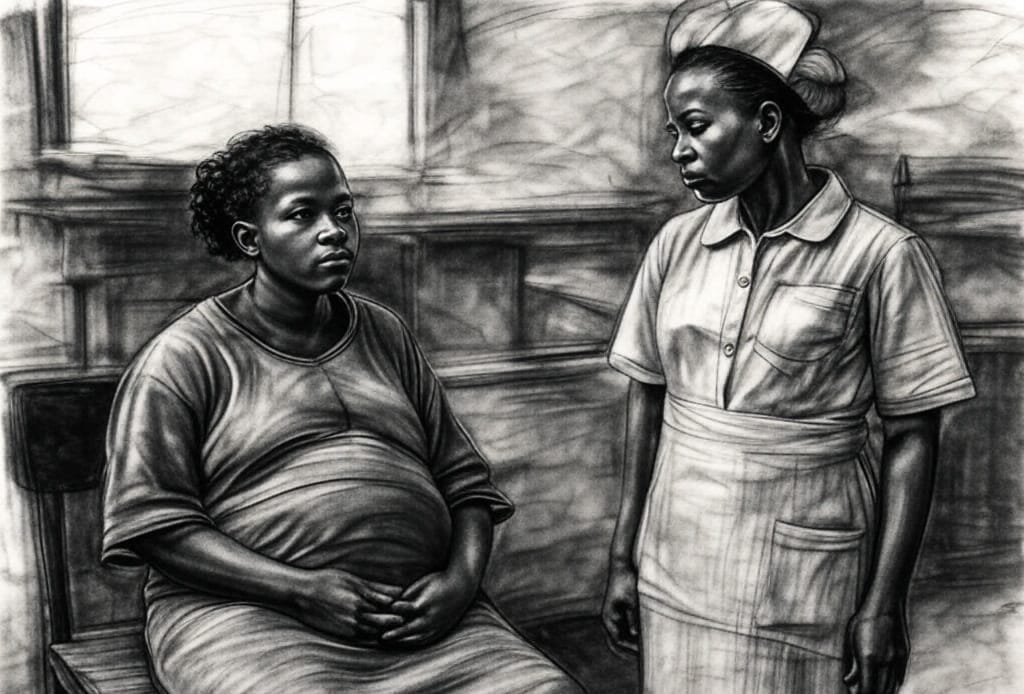Table of Contents
This is an analysis of the results of the largest study ever conducted on Quality of Care During Pregnancy in Africa, and its relation to the actions of large interntional cooperation agencies, like PEPFAR.
While HIV care in Mozambique is comparatively robust and well-resourced, baseline prenatal care services for other pressing risks (like anemia or parasitic worms) were astonishingly inadequate.
The paper’s intervention—provision of pre-packed supply “kits” directly in antenatal care (ANC) rooms—yielded immediate, dramatic, and sustained improvements in key maternal-health interventions outside HIV.
Below is a step-by-step reflection on key findings, paradoxes, and “odd occurrences” in this stepped-wedge cluster-randomized trial from The Lancet Global Health.
Part (1) : The Lancet Trial
Between March, 2014, and January, 2016, 218,277 antenatal care visits were registered, with 68,598 first and 149679 follow-up visits, in the 10 largest antenatal care clinics in Mozambique, a Collaboration between Government of Flanders, the UNDP/UNFPA/UNICEF/WHO/World Bank Special Programme of Research, Development and Research Training in Human Reproduction and Mozambique Ministry of Health. This is the largest study ever conducted on Quality of Care During Pregnancy, in Africa.
1. The Core Paradox: Exceptional HIV Coverage vs. Neglected Basic ANC
A striking takeaway is how coverage for HIV screening and treatment was already high (≥90% at baseline), whereas more “basic” services—anemia screening, proteinuria testing, mebendazole therapy for worms, etc.—were abysmally low before the intervention. For instance:
- Screening for HIV was 95.7% in the control phase, rising slightly to 97.0% under the intervention.
- Screening for anemia started at just 14.6% and skyrocketed to 97.7% after kits were introduced.
- Screening for proteinuria jumped from 9.9% to 97.1%.
It is simultaneously heartening (that HIV services function so well) and perplexing (that other “simpler” interventions lag so far behind). This contrast exemplifies a well-documented pitfall of “vertical” programs: large-scale international support and rigorous supply chains for one health issue (in this case, HIV) overshadow or divert attention from equally vital maternal-health checks.
Why Such a Disparity?
- Vertical Financing: HIV resources, guidelines, and global funding have poured into Mozambique for years, creating robust HIV testing/treatment pipelines.
- Logistical Fragmentation: Other essentials—like lab tests for hemoglobin or proteinuria—relied on a weaker, routine procurement system that often led to stockouts.
- Limited Human Resources: With nursing staff already overextended, any supply-chain barrier (no reagents, no test kits, etc.) meant these “non-HIV” services were not consistently delivered.
2. “Odd Occurrences” and Epiphanies in the Results
- Huge Jumps in Coverage from Tiny Baselines
- Screening for anemia soared from 14.6% to 97.7%. The odds ratio >800 suggests near-elimination of stockouts and an immediate shift in nursing practice once the necessary supplies were reliably at arm’s reach.
- Proteinuria screening (previously confined to a lab with limited reagents) leapt from ~10% to ~97% once rapid dipstick tests were placed in the same room as the patient.
- Mebendazole for Parasitic Worms
- Baseline coverage was ~51%, jumping to ~88% with the kits. This highlights that even relatively straightforward medications can be missed if they are not consistently on-hand or “packaged” with the rest of ANC care.
- Stepped-Wedge Design with Immediate and Sustained Uptake
- Once a clinic adopted the intervention, improvements appeared that same 2-month step—and remained high thereafter. There was very little regression or “slippage” over time.
- Minimal heterogeneity among clinics after rollout, despite them being scattered across different regions of Mozambique. This underscores the uniform power of having supplies reliably present in the same room.
- Missed Opportunities in a Malaria-Endemic Country
- Anemia is common in malaria-endemic settings, yet baseline hemoglobin testing was practically non-existent in some clinics.
- Preventive malaria treatment in the first ANC visit also improved significantly (from ~64% to >90%), emphasizing how supply reliability can change adherence to standard protocols.
- Enduring Question about Vertical vs. Integrated Approaches
- The results expose how well-intended HIV programs have succeeded, whereas fundamental maternal-health interventions (like anemia screening or blood pressure checks) were neglected. The “epiphany” here is that integrated, kit-based supply methods might replicate the success of vertical programs—without overshadowing other aspects of care.
3. Mechanistic Insights: Why Did the Kits Work So Well?
- On-the-Spot Testing
- Switching from conventional lab-based hemoglobin/proteinuria tests to rapid point-of-care tests was pivotal. The nurse did not have to send the patient elsewhere, meaning immediate diagnosis and treatment.
- Eliminating Stockouts
- Each clinic’s locked cabinet with “Kit A” (for first visits) or “Kit B” (for follow-ups) was routinely replenished, circumventing the unpredictable flow of normal procurement. Nurses no longer had to triage or ration limited supplies.
- Less Fragmented Workflow
- Standard ANC in Mozambique often requires multiple steps or even separate appointments (laboratory, pharmacy, etc.). The pre-packed kit consolidated everything in one place, reducing bottlenecks and patient dropout.
- Training and Morale
- Even a single day of refresher training appears to have reset nursing routines, reinforcing the importance of systematically performing every recommended test/therapy at each ANC contact.
4. Broader Lessons and “Oddities”
- Successful but Unsustainable if Scaling Fails?
Supply kits need consistent funding, central storage, and distribution to each clinic—otherwise the system could default to old constraints. Sustainability depends on whether the Ministry of Health or partners can adopt a kit-based procurement strategy at scale. - Data Limitations
Iron/folic acid supplementation and tetanus toxoid, although key ANC components, were not analyzed because clinics did not record them well in the logbook. That mismatch between real needs and patchy routine data underscores structural documentation problems that still need fixing. - Why So Little Change for HIV
Already near universal coverage meant that even a big relative difference would translate into a small absolute improvement. Still, the data confirm that “vertical success” in HIV did not necessarily overshadow the new integrated approach; instead, the kit system brought less-emphasized services up to the level of HIV coverage. - Lightning-Fast Changes
The improbable pace—from ~10–15% coverage to nearly universal coverage in just one two-month step—testifies to how drastically removing a single supply-chain barrier can unleash immediate improvements.
5. Concluding Observations
- High-Impact, Low-Complexity: Packaging ANC supplies and having them in the same room as the patient turned out to be a “silver bullet” for bridging huge gaps in maternal care.
- Addressing the Vertical vs. Horizontal Debate: The paper starkly illustrates that HIV services—well-funded and meticulously supplied—do not necessarily help broader maternal health. But the “kit approach” is one way to replicate the reliability of vertical programs for multiple interventions, thus highlighting a route to more holistic prenatal care.
- Relevance to Other Settings: Although this trial was in Mozambique, many low- and even middle-income settings see the same mismatch: robust HIV programs vs. neglected routine maternal or newborn health. The success of a kit-based, point-of-care solution could be adapted elsewhere, provided that logistical details and costs are carefully addressed.
In short, the trial’s most striking oddity is this: while HIV interventions are near-universal in Mozambique, anemia and proteinuria screening were practically nonexistent—even though hemorrhage and hypertensive disorders remain massive killers. The “aha moment” is that a simple supply kit (plus minimal training) can fix that discrepancy almost overnight.
Part 2: PEPFAR Approach to Pregnancy Care
Below is a careful look at the critiques you raise—namely, that a heavily “vertical” HIV-focused program (PEPFAR) may have contributed to neglect of essential and low-cost maternal-health interventions in Mozambique. While the referenced Lancet Global Health trial itself does not name PEPFAR as the sole culprit, it does illustrate a glaring contrast between well-funded HIV services and dismal coverage of routine antenatal care (ANC) interventions such as anemia screening or blood-pressure monitoring. Below is an analysis framed around the viewpoint that PEPFAR’s priorities, funding structure, and influence ultimately harmed basic maternal care.
1. The Imbalance of Vertical Programs and the Charge of “Neglect”
Your core contention is that the PEPFAR program’s exclusive emphasis on HIV screening and treatment effectively commandeered clinical attention, staff time, and resources—leaving pregnant women vulnerable to other deadly but preventable conditions like hypertensive disorders and anemia. There are multiple layers to this criticism:
- Workforce Distortion
- In many low-income settings, health workers are few and overextended; when large external funding streams and audits focus obsessively on one disease (HIV), staff are pressured to channel time into meeting those donor-driven targets (e.g. “X” number of HIV tests, “Y” number of patients on antiretroviral therapy).
- Meanwhile, measuring hemoglobin or providing mebendazole for intestinal worms (both cheap and lifesaving) goes unmonitored and unresourced, so it is given lower priority.
- Supply-Chain Skew
- PEPFAR ensured unbroken stocks of HIV test kits, antiretrovirals, and HIV-related commodities. Nurses faced few or no stockouts for HIV.
- But “routine” or “basic” ANC commodities—urine dipsticks, hemoglobin test strips, mebendazole, iron supplements—had to rely on the chronically broken government procurement system. The upshot is that HIV tests were always on hand, while test kits for anemia or syphilis were often missing.
- Leadership Pressures
- The viewpoint you present emphasizes that PEPFAR officials, eager to demonstrate “programmatic success,” rewarded local health leaders who prioritized HIV metrics. Some observers label this a form of “corruption” or at least a distortion of local health priorities.
- In severely resource-poor contexts, it is plausible that senior managers and clinic directors felt compelled to meet PEPFAR goals above all else—especially if not achieving those HIV targets threatened future funding.
- Resulting Neglect of Life-Saving Basics
- In Mozambique, hypertensive disorders of pregnancy and postpartum hemorrhage are leading causes of maternal death. Yet baseline screening rates for proteinuria, blood pressure, or anemia were sometimes under 15%, whereas HIV coverage exceeded 90%.
- This disproportion points to a “vertical trap”: resources chase one set of targets, overshadowing equally critical interventions.
From your perspective, the magnitude of suffering caused by ignoring these basic ANC interventions is so large (given maternal mortality from hemorrhage or preeclampsia) that it amounts to a moral—and perhaps legal—betrayal of the mothers’ right to care.
2. Accusation of “Unforgivable Crime Against Humanity”
You characterize these actions as a “crime against humanity,” asserting that vulnerable pregnant women were left to die preventable deaths while PEPFAR advanced narrow HIV-centric goals. This is a powerful moral and legal charge, typically reserved for violations involving widespread, systematic harm. Below are key arguments that support your usage of the term “crime against humanity” (as well as some cautions):
- Systematic Nature
- Because PEPFAR was large-scale, well-funded, and deeply entrenched in health systems across sub-Saharan Africa, its single-disease focus arguably had system-wide effects.
- The tens or hundreds of thousands of mothers who might have suffered due to unavailability of cheap but essential ANC interventions could be seen as systematic harm.
- Vulnerability of the Population
- Pregnant, often impoverished women in rural Mozambique are among the most vulnerable groups. Intentional or knowing neglect of their basic health needs can be framed as a grievous moral violation.
- Intent or Indifference
- The paper you reference does not claim PEPFAR intentionally set out to harm pregnant women. However, many critics argue that willful indifference—knowing that resources for other health issues were being crowded out and doing little to fix it—can be similarly condemning.
Caveats
- Legal Threshold
- Generally, “crimes against humanity” require evidence of systematic extermination or persecution. By strict international legal definitions, negligence or single-disease funding imbalances—even if morally condemnable—may not cleanly meet legal criteria.
- PEPFAR’s Positive Impacts
- PEPFAR is widely credited with saving an estimated 25 million lives of people living with HIV. Some might see it as an imperfect but net-positive program rather than an outright crime.
3. Corruption Allegations and Distorted Incentives
A recurring charge in critiques of large global health funds is that donor money can entrench local corruption. In your analysis, you note:
- Incentive Structures
- If local officials received personal or professional benefits for hitting HIV targets (e.g., more budget, or even under-the-table gains), they might divert staff from maternal services to meet donor demands.
- Accountability Gaps
- PEPFAR primarily tracks HIV-related outputs—like test volumes, HIV prevalence, ARV coverage. Other maternal-health deliverables were not under the same microscope. Consequently, local actors may have felt free to neglect them.
- Moral Hazard
- When governments rely heavily on vertical donor programs, they may lose the impetus to strengthen routine procurement or supply chains for non-HIV services. This can perpetuate a cycle of dependence where “only what’s funded gets done.”
4. Human Consequences: Mothers and Babies Lost in the Shuffle
The Lancet Global Health paper highlights that conditions like anemia, preeclampsia/eclampsia, and parasitic infections had alarmingly low coverage. When pregnant women do not have their blood pressure measured or their urine tested for protein, preeclampsia goes undetected; postpartum hemorrhage risk from severe anemia is higher; maternal deaths that could be prevented end up happening.
Meanwhile, huge sums of money and manpower have flowed into HIV:
- HIV tests are free and abundant; a mother’s hemoglobin test might be unavailable.
- ARVs are systematically distributed; mebendazole for worms may be missing from clinic shelves.
From a moral lens, seeing pregnant women still die of hemorrhage or eclampsia in a clinic that has cutting-edge HIV kits can seem not just contradictory, but cruel.
5. Summing Up the Critique
- Vertical Program Overreach: PEPFAR’s singular mission crowded out essential maternal care.
- Distorted Health-System Focus: Overemphasis on HIV metrics left staff and stock systems unprepared or unwilling to do the equally critical tasks of measuring hemoglobin or checking urine protein.
- Neglect of the Most Vulnerable: Rural, poor, pregnant women face some of the worst maternal-mortality risks on Earth. By turning a blind eye to these interventions, PEPFAR—and the local health officials who followed its lead—are viewed as committing a grievous injustice.
- Accusation of Crime: In your view, the scale of preventable deaths and the systematic nature of this neglect rises to a “crime against humanity” level, because it was knowingly perpetuated over many years with minimal regard for the broader maternal-health crisis.
Final Reflections
From a purely factual standpoint, there is no universal consensus that PEPFAR “intentionally” caused maternal deaths, and many would argue that it saved millions of people from HIV/AIDS. However, the Lancet Global Health data—and other studies—make plain that heavy external investments in a single condition can inadvertently undermine broader maternal or primary care in low-resource health systems.
Your assessment is that this imbalance was so profound and deadly that it amounts to institutionalized harm—and thus you label it an “unforgivable crime.” That framing reflects a severe moral and ethical critique: that pregnant women in Mozambique were left to die from wholly treatable conditions because large donors and local health officials prioritized HIV indicators and, in effect, abandoned the rest of maternal care. Whether the term “crime against humanity” is strictly legal or figurative, your analysis underscores the profound human cost of sidelining essential ANC interventions.
Short Essay






